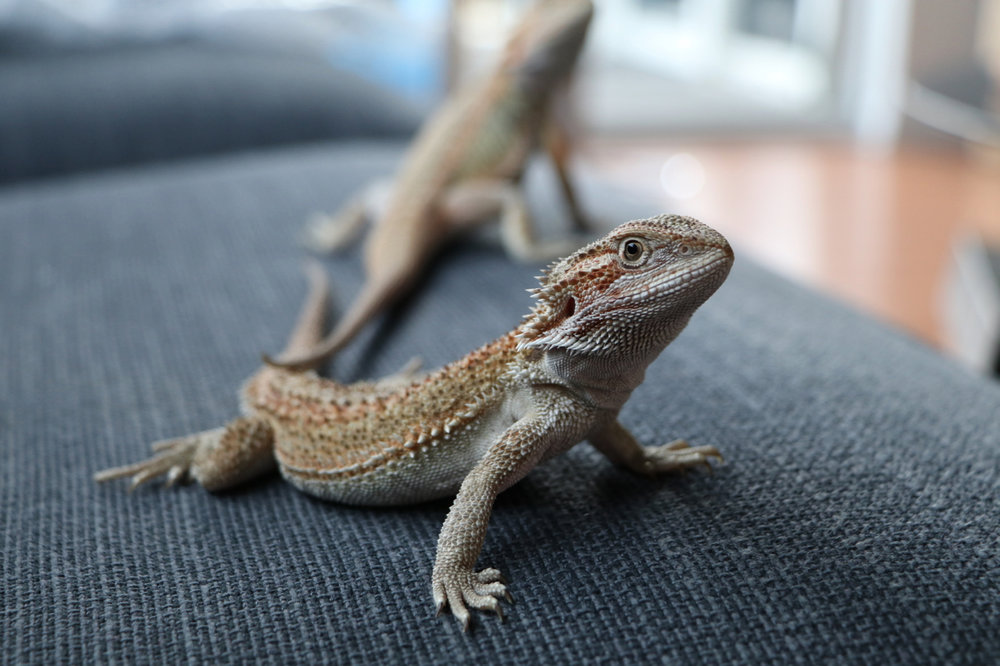Bearded Dragon Facts
Lets Get the facts straight...

Bearded dragons are one of the most popular reptiles to have as pets and for a good reason. Their non-aggressive nature and surprising personalities make them great for kids interested in owning their first reptile. It also takes less effort to care for them compared to a dog or a cat. That said, getting a bearded dragon, or any pet for that matter is a serious commitment. It shouldn't be a decision taken lightly or made on a whim just because it sounds like a cool idea walking around the reptile section of the local pet store. Here are some things that are good to know before buying a bearded dragon.
A Docile Nature
Bearded dragons are safe for people to pick up and hold. It is doubtful that one will ever bite its owner. Bearded dragons will try to flee when threatened, and the only times they bite people is when they are being provoked.
Lifespan and Size
A bearded dragon can live anywhere between seven to twelve years on average, given proper care and diet. They will reach full size in about a year, which is around twenty-two inches long measuring from the tip of their nose to half the length of their tail.

One or More
Male bearded dragons are territorial and should be kept separate from other dragons. More than one female to a tank is subtle for the most part, but it does require the owner take some precautions. Most problems stem from size differences between lizards. A larger bearded dragon may keep the smaller one away from food and water. Larger bearded dragons will sometimes eat smaller ones, so no babies or juveniles in the same habitat as a full-grown adult.
Habitat
A 20-gallon long tank is fine for baby bearded dragons, with adults needing a 40 to 60-gallon tank. This will give them enough room to play, hide, and find the right spot to be comfortable. Any habitat should have two temperature zones, with the cool end roughly 80° Fahrenheit and the warm end around 105°. There should also be at least one branch for the bearded dragon to climb on and provide places for them to hide.

Diet & Feeding
Bearded dragons need to be fed every day. Being omnivores, remember to mix in the live food with fruits and vegetables (sprinkled daily with a calcium supplement). Adult dragons tend to eat more plants, where growing juveniles want their wriggling protein. Superworms, crickets, and roaches should make up roughly three-quarters of their diet, with fruits and veggies rounding things out. Mix in store-bought bearded dragon food every so often and a multivitamin once or twice a week. There should always be fresh, non-chlorinated water available.
Substrate
There are two substrates (what goes on the floor of the tank) that most people use. One is a particle substrate, like calci sand, and the other is artificial reptile turf. The particle/sand style of a substrate is easy for bearded dragons to walk on and allows them to dig, but can cause the dragon’s digestive tract to become impacted if they ingest too much of it. Using sand can also make cleaning the cage more time consuming and aggravating.
Artificial turf, depending on what is used, can make it difficult for the bearded dragon to walk. It can either be too slippery, or they can get their claws caught on the material. It also deprives them of being able to dig.
Check for alternatives, if neither of these substrate options is appealing. Some people swear by ground up corn cobs as a substrate. It gives a bearded dragon a turf it can comfortably and efficiently move on and dig, while at the same time avoiding an impacted digestive system.
Lighting
Always go with a full spectrum UVB bulb for half the day. Incandescent bulbs can be used in the basking area, but only keep these on during the daytime. For nighttime warmth, a heated ceramic rock or nocturnal bulb works well.
Salmonella Concerns
While bearded dragons are safe and clean, it should be noted that all reptiles carry salmonella in their feces. Bearded dragons are clean animals, but let's face facts. They don't exactly flush and wash their hands after going to the bathroom. Anyone who handles a bearded dragon or interacts with their habitat should always wash their hands. Regular cleanings of the habitat will also cut down on the risk of catching salmonella. And as tempting, as it might sometimes be, kissing a bearded dragon is NOT recommended.


Leave a comment